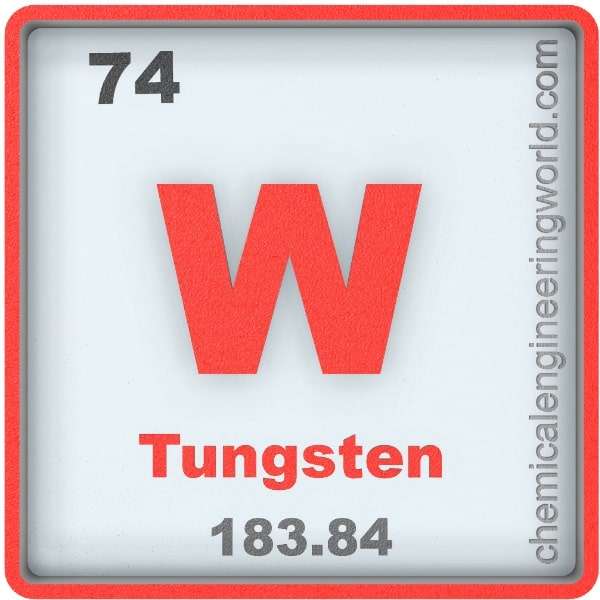Tungsten Element Properties and Information

Tungsten Element Properties and Information
Tungsten is 74th element on the periodic table. Elements are arranged in the periodic table on the basis of the atomic number. Atomic number is the number of protons in the nucleus of the atom. Tungsten has an atomic number of 74. It is located in the Group 6 and Period 6 of the periodic table of elements. It is denoted by ‘W’. Its name is derived from Swedish ‘Tung Sten’ which means ‘Heavy Stone’.
A tungsten-pigment was utilised by porcelain makers in China about 350 years ago but the metal Tungsten was not known officially as an element which has its own place on the periodic table. Peter Woulfe had examined a mineral from Sweden and had concluded that it contained a new element. Wilhelm Scheele investigated it and isolated an oxide which he also deduced that it is a new element in 1781. The credit of discovering the element is given to Juan and Fausto Elhuyar who not only isolated the oxide but also reduced it to a metal using carbon in 1783.
Tungsten is never found in nature in a free state, always combined with other elements. It is a rare element and the only minerals which are used industrially to obtain tungsten are either wolframite and scheelite, all other minerals have no economical value.
Physical Properties
- Tungsten metal has a steel-grey appearance and it is hard & brittle.
- The atomic mass of tungsten is 183.85.
- The melting point of tungsten is 3410°C.
- The boiling point of tungsten is 5660°C.
- The density of tungsten is 19300 in S.I. units at 20°C.
- The brittle tungsten is hard to work with, it is purified which causes it to become malleable and thus easier to work with.
- Among all the metals in pure form; tungsten has the highest tensile strength & melting point and when temperatures are above 1650°C, it has lowest vapour pressure. Also, it has lowest thermal expansion among all pure metals.
- Tungsten exists majorly in two forms; one of them is stable and has body-centered-cubic structure and the other is metastable.
- Naturally occurring tungsten is composed of 5 isotopes among which 4 are stable and 1 is radioactive. The stable isotopes are; tugsten-182, tungsten-183, tungsten-184, and tungsten-186. The radioactive isotope is tungsten-180.
Chemical Properties
- Tungsten metal is mostly non-reactive in nature.
- Tungsten does not react with water, oxygen, or air at room temperature.
- Tungsten is immune to most acids and bases.
- Tungsten reacts with oxygen at elevated ‘red-hot’ temperatures to form a tri-oxide.
- Tungsten reacts readily with fluorine at room temperature to form tungsten(VI) fluoride.
- At 250°C, tungsten reacts with bromine and chlorine.
- Tungsten is the only element in the third transition series which is known to occur in biomolecules.
Methods of Production
Reduction: The ores goes through variety of pre-processing such as crushing, magnetic separation, froth-flotation, etc then chemical steps are carried out to bring the tungsten in the form of tungsten(VI) oxide. The primary step is to reduce this compound to tungsten metal using carbon or hydrogen. The tungsten is obtained in the powdered form. It is not feasible to make it into ingots thus the powdered tungsten is mixed with nickel or some other metal and sintered.
Relevance in Chemical and Related Industries
- Tungsten Carbide: Tungsten is used mostly to make tungsten carbide which is used to make variety of hard materials such as abrasives, knives, drills, saws, dies, and variety of cutting and milling tools.
- Alloys: Tungsten is combined with other metals to make variety of heat-resistant and wear-resistant alloys.
- Chemical Compounds: About 10% of the tungsten produced worldwide goes in making variety of tungsten compounds; tungsten(IV) sulphide is used in catalysts for hydrodesulfarization process, crystal tungstates are used in scintillation detectors, tungsten oxide is used in selective catalytic reduction, etc.
Relevance in Other Industries
- Millitary: Tungsten alloyed with other metals finds good applications in military, it has been used in bullets, grenades, shells, and missiles.
- Jewellery: Tungsten has density which is quite similar to gold; hence it has often been used as a substitute for gold. It has also been used as a substitute for platinum.
- Electronics: Because of tungsten’s ability to retain strength at high temperatures along with having a very high melting point, it finds many applications in the electronics industry; incandescent lights, vacuum tube filaments, cathode-ray tube, heating elements, integrated circuits, field emission guns, nanoelectronics, etc.
Health Effects on Exposure
Irritant: Contact of tungsten with any body part irritates the part; redding, scaling, and itching can be seen on those organs. Prolonged exposure also leads to inflammation.
Effects on Surroundings
Tungsten is not expected to be harmful to environment.
References:
https://en.wikipedia.org/wiki/Tungsten
https://www.lenntech.com/periodic/elements/w.htm
https://www.rsc.org/periodic-table/element/74/tungsten
































